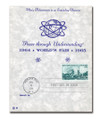
1964 5c New York World's Fair
# 1244 - 1964 5c New York World's Fair
$0.35 - $23.00
U.S. #1244
5¢ New York World's Fair
5¢ New York World's Fair
Issue Date: April 22, 1964
City: New York, NY
Quantity: 145,700,000
Printed by: Bureau of Engraving and Printing
Printing Method: Rotary Press
Perforations: 11 x 10 1/2
Color: Blue green
City: New York, NY
Quantity: 145,700,000
Printed by: Bureau of Engraving and Printing
Printing Method: Rotary Press
Perforations: 11 x 10 1/2
Color: Blue green
U.S. #1244 commemorates the opening of the 1964 New York Worlds Fair.The stamp pictures the fairs main mall, including the Unisphere (a 12-story stainless-steel model of the earth).
U.S. #1244
5¢ New York World's Fair
5¢ New York World's Fair
Issue Date: April 22, 1964
City: New York, NY
Quantity: 145,700,000
Printed by: Bureau of Engraving and Printing
Printing Method: Rotary Press
Perforations: 11 x 10 1/2
Color: Blue green
City: New York, NY
Quantity: 145,700,000
Printed by: Bureau of Engraving and Printing
Printing Method: Rotary Press
Perforations: 11 x 10 1/2
Color: Blue green
U.S. #1244 commemorates the opening of the 1964 New York Worlds Fair.The stamp pictures the fairs main mall, including the Unisphere (a 12-story stainless-steel model of the earth).












